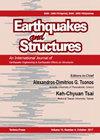双线性滞回隔震系统的等效线性和边界分析
IF 1.1
4区 工程技术
Q3 ENGINEERING, CIVIL
引用次数: 0
摘要
在过去的几十年里,经过许多相关研究的验证,采用等效侧向力程序设计隔震结构作为初步甚至最终设计方法已经相当成熟,并为公众所接受,尤其是对于机械表现出双线性滞回特性的隔震系统。在设计过程中,除了给定的抗震需求外,结构设计师还需要预先确定三个参数,如隔震系统的力学性能或隔震结构的设计参数和性能指标。然而,任意或不适当地选择给定的参数可能会导致不同甚至不可接受的设计结果,从而给结构设计师带来很大的困扰。在本研究中,首先,基于隔震结构的至少两个设计参数或两个性能指标是预先确定的标准,检验了不同条件下设计结果的合理性和适用性。此外,为了考虑由于隔震系统力学性能的不确定性导致的隔震结构设计参数的变化,采用其中一个条件进行隔震设计的边界分析。分析结果表明,在设计合理的等效阻尼比的情况下,考虑两个设计参数(有效刚度和等效阻尼比)的特定变化,可能会比考虑相同变化但具有两种机械性能(特征强度和屈服后刚度)的边界设计结果(就隔震位移和加速度传递率而言)更保守。本文章由计算机程序翻译,如有差异,请以英文原文为准。
Equivalent linear and bounding analyses of bilinear hysteretic isolation systems
With verifications through many relevant researches in the past few decades, adopting the equivalent lateral force
procedure for designing seismically isolated structures as a preliminary or even final design approach has become considerably
mature and publicly acceptable, especially for seismic isolation systems that mechanically exhibit bilinear hysteretic behavior.
During the design procedure, in addition to a given seismic demand, structural designers still need to previously determine three
parameters, such as mechanical properties of seismic isolation systems or design parameters and performance indices of
seismically isolated structures. However, an arbitrary or improper selection of given parameters might cause diverse or even
unacceptable design results, thus troubling structural designers very much. In this study, first, based on the criterion that at least
either two design parameters or two performance indices of seismically isolated structures are decided previously, the rationality
and applicability of design results obtained from different conditions are examined. Moreover, to consider variations of design
parameters of seismically isolated structures attributed to uncertainties of mechanical properties of seismic isolation systems, one
of the conditions is adopted to perform bounding analysis for seismic isolation design. The analysis results indicate that with a
reasonable equivalent damping ratio designed, considering a specific variation for two design parameters (the effective stiffness
and equivalent damping ratio) could present more conservative bounding design results (in terms of isolation displacement and
acceleration transmissibility) than considering the same variation but for two mechanical properties (the characteristic strength
and post-yield stiffness).
求助全文
通过发布文献求助,成功后即可免费获取论文全文。
去求助
来源期刊

Earthquakes and Structures
ENGINEERING, CIVIL-ENGINEERING, GEOLOGICAL
CiteScore
2.90
自引率
20.00%
发文量
0
审稿时长
>12 weeks
期刊介绍:
The Earthquakes and Structures, An International Journal, focuses on the effects of earthquakes on civil engineering structures. The journal will serve as a powerful repository of technical information and will provide a highimpact publication platform for the global community of researchers in the traditional, as well as emerging, subdisciplines of the broader earthquake engineering field. Specifically, some of the major topics covered by the Journal include: .. characterization of strong ground motions, .. quantification of earthquake demand and structural capacity, .. design of earthquake resistant structures and foundations, .. experimental and computational methods, .. seismic regulations and building codes, .. seismic hazard assessment, .. seismic risk mitigation, .. site effects and soil-structure interaction, .. assessment, repair and strengthening of existing structures, including historic structures and monuments, and .. emerging technologies including passive control technologies, structural monitoring systems, and cyberinfrastructure tools for seismic data management, experimental applications, early warning and response
 求助内容:
求助内容: 应助结果提醒方式:
应助结果提醒方式:


